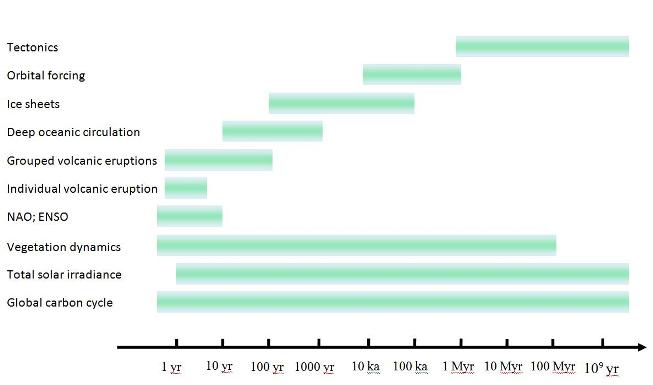5.1 Introduction
Since the beginning of Earth’s history, climate has varied on all timescales. Over millions of years, it has swung between very warm conditions, with annual mean temperatures above 10o C in Polar Regions and glacial climates in which the ice sheets covered the majority of the mid-latitude continents. It has even been postulated that, in some past cold periods, the whole surface of the Earth was covered by ice (this is the snowball Earth hypothesis). At the other end of the spectrum, lower amplitude fluctuations are observed on interannual and decadal timescales, no year being exactly the same as a previous one.
The timescale of these variations is partly set up by the forcing (Fig. 5.1). Because of its own stellar evolution, the radiation emitted by the Sun has increased by roughly 30% over the 4.5 billion years of the Earth's history. Variations in the total solar irradiance on shorter timescales have a smaller amplitude, although this amplitude is not precisely known (see section 5.5). The low frequency changes of the characteristics of the Earth orbit (see section 5.4.1) modify the amount of solar energy received in a particular season on every point on the Earth's surface, with the most important fluctuations located in the 10-100 ka range. Individual volcanic eruptions produce a general cooling during the years following the eruption (see section 5.5.2 ). Furthermore, volcanic activity can be responsible for low frequency forcing if large eruptions are grouped in a particular decade or century. On longer timescales, increased volcanic activity related to plate tectonics can lead to a strong forcing lasting thousands to millions of years.
On the other hand, internal dynamics also play a very important role in determining the variability of the Earth's climate. They can be a direct cause of variability, in the absence of any significant change in the forcing, through interactions between various elements of the system. Important examples are the El Niño Southern Oscillation (ENSO), the North Atlantic Oscillation (NAO) and the Southern Annular Mode (SAM). Secondly, because of the large inertia of the ocean and the ice sheets, the dominant effect of a perturbation can be related to the integration of the forcing over long time scales while higher frequency changes are damped. Inertia can also induce a delayed response to a perturbation (see section 4.1.4). Furthermore, the response of the system can involve complex mechanisms that lead to large differences between the characteristics of forcing and those of the climate changes induced by the forcing. For instance, if a forcing excites one mode of internal variability of the system at a particular frequency, leading to a kind of resonance, the magnitude of the response at that frequency will be large even though the forcing is not particularly intense at that frequency. Small changes in the forcing can also lead to large variations in the climate system if a threshold is crossed and, as a result the system evolves (nearly-) spontaneously from one state to another, possibly quite different, one. Such a transition, involving the deep oceanic circulation, has been proposed to explain some of the abrupt climate changes recorded in Greenland ice cores during the last glacial period.
This brief overview has described a few of the processes that have to be combined to explain past climate changes. Below, we will illustrate some of the most important concepts, starting with the variability that is due to internal processes only. For this, we will focus on processes characterised by relatively high frequency variations, because they are the ones for which we have the most information. The components of the climate system that are mainly involved in those modes of variability are the atmosphere and the surface layer of the ocean. The internal variability of the deep ocean circulation and the ice sheets will not be discussed here. We will then review past climate changes, starting with very long timescales and finishing with the last millennium.

|




